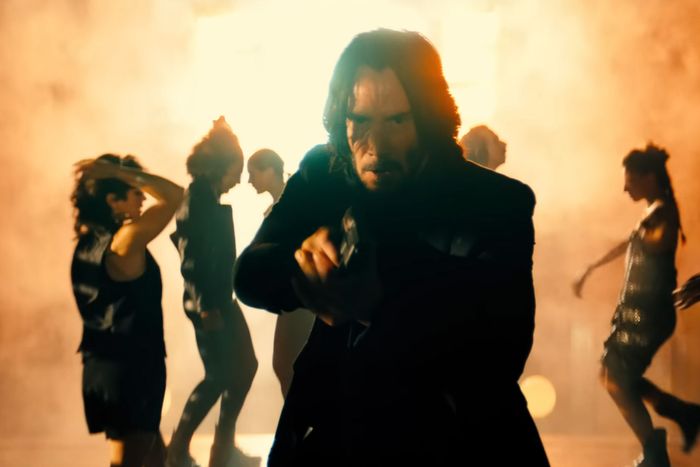
Spoilers follow for John Wick: Chapter 4 and the preceding films John Wick, John Wick: Chapter 2, and John Wick: Chapter 3 – Parabellum.
The John Wick franchise has always required a committed suspension of disbelief. Not because Keanu Reeves isn’t believable as a lissome assassin who never misses in either sharpshooting or fashion, but because over four films, the child of the Ruska Roma crime family gets besieged in more and more outlandish places. The face-offs that started with a break-in at Wick’s house have since traveled to antique weapons stores and Casablanca casbahs; New York City tunnels, bridges, harbors, and public libraries; and European museums and churches, with no civilians ever getting caught in the crossfire. (Wick and his assassin colleagues are just that precise, okay?) And while every new arena is an opportunity to watch Reeves’s hitman adapt to new obstacles, there is one location that the films return to over and over: the neon-lit nightclub. The Baba Yaga doesn’t respect cover charges or door fees, and he’s one of the best party crashers cinema has ever had.
Pulsing with light, music, and rhythmic movement, raves and clubs pop up every so often in action films, which makes sense since the genre is so interested in the physicality of the human body. They can be an ideal space to observe heightened states of being — fear, lust, euphoria — and modes of movement. Consider the opening scene of Blade and how quickly those blood sprinklers turn ecstasy into terror, revealing the otherness of a bunch of hungry vampires.
And don’t forget the much-maligned-but-actually-great Zion rave in The Matrix Reloaded, the second installment in Reeves’s other big action franchise. That scene cuts back and forth from revelers in the last human city leaping, grinding, and relishing their freedom, to Reeves’s Neo and Trinity (Carrie-Anne Moss) making love, emphasizing the joys and raptures of being human. The rave was a marked contrast from the previous film’s club-set scene, in which a repressed Neo stands motionless in a room full of unfettered movement. In Zion, now free of simulated-reality monotony, Neo finds a balance between abandon and restraint.
The John Wick films play with similar ideas about flesh and indulgence in their nightclub scenes, which appear in John Wick, John Wick: Chapter 2, and — in a dizzying return to form — John Wick: Chapter 4. Each is a whirlwind of action design in which Reeves’s solo avenger goes up against swarms of baddies who attack him with everything they’ve got. While everyone around them dances for pleasure, Wick and his enemies parry and pirouette for the upper hand. It’s a beautiful brawl, reflecting the franchise’s foundational appreciation for the potential of the human form. (The third installment, Parabellum, has many high points, like the Continental glass-room fight, but its lack of dance floors is a definite downside.)
Sensory overload is the John Wick way, and especially so during these nightclub scenes. The bass-heavy songs are loud enough to melt your brain; the purple-blue-red-pink lights flash every which way; and then there’s Wick, cutting his way through it all — his finely honed precision juxtaposed with debaucherous excess. The first film sets the template, with Wick infiltrating a club called the Red Circle, stabbing his way through the basement-pool level, stifling heavies’ screams, and then chasing mobster Iosef Tarasov (Alfie Allen) through the upper level. Every production choice here — Kaleida’s electropop song “Think,” the bisexual lighting, the restaurant-ware (drink glasses, Champagne bottles) as impromptu weaponry, clubbers parting and coalescing around Wick until the gunfire starts — adds up to a thrilling demonstration of Wick’s single-mindedness and the franchise’s heightened atmospherics.
John Wick: Chapter 2 goes bigger, sending Wick to Rome’s Baths of Caracalla ruins for a coronation ceremony that has all the same components of the Red Circle scene, but scaled up. This time, there’s a live performance of two more ambient, operatic songs from the musician Nostalghia, blood-red light irradiating a gigantic stage, and hundreds of people making way for Wick — even cheering as he ends up on the platform above them. It’s a perfect example of how these films get more ambitious with each installment but also honor what they know works: elaborate set pieces that show Reeves’s ability to retain focus, no matter how many distractions are in his way.
That brings us to John Wick: Chapter 4, in which Reeves’s Wick is in Berlin to kill a baddie named — wait for it — Killa (martial-arts icon Scott Adkins, in a disappointing fat suit). Shot at the brutalist Kraftwerk Berlin, a power station turned exhibition space, this scene takes everything great about the Wick club scenes before it and intensifies it to put Wick under as much pressure as possible. An instrumental synth track is a sinuous thrum in the background, while lens flares and swirling lights silhouette the dancers unbothered by Wick and Killa’s antics. There are bursts of fire and pipes spewing water, soaking the men as they run up and down the club’s stairwells (and sometimes tumble over them). And all that simulated rain only enhances the slickness of fight choreography. Case in point: when Wick grabs an axe being swung at him by one of Killa’s henchmen and then uses it against another henchman. Our guy is nothing if not resourceful!
If John Wick: Chapter 4 really is the end of this saga, there’s a nice poetry to the franchise ending so similarly to how it began: Wick defends a dog, identifies himself as a “loving husband” above all, and goes out on his own terms. The whole world was John Wick’s dance floor, and what a delight to watch him bust a move (and some heads).
related
- A Ranked Guide to John Wick–Inspired Movies
- The Beatific Imperfection of Keanu Reeves in The Matrix
- Lionsgate Adds The Crow Reboot in Release Schedule, Delays Ballerina Until 2025


